

How Holacracy Works - WonderWorks Consulting. Let Us Explain How Holacracy Works?

We’ve put Holacracy® to the test in a wide array of organizations and industries: from big corporations to family-run businesses to our own team and households. We know it inside and out: its power and what it takes to maximize its success. We know the common resistances and pitfalls that arise when implementing Holacracy. That’s why we include masterful coaching and facilitation to align each individual with the essential purpose of your organization — moving you towards your result. We integrate our vast years of conscious people leadership experience with customized best practices, proven strategies, and the smartest business strategy. Simply put: your team will get more done and love coming back to work the next day. How does Holacracy® Create Conscious Organizations?
An Alternative To Holacracy: Unlocking Ideas For The Best Results. The jury is still out on whether the “no managers, self-governing” management trend called holacracy is here to stay.

Recent news that online retailer Zappos is shifting to a holacratic model drew a fair bit of attention, at least among the chattering class. The notion that an organization can run better by flattening management and ditching job titles is a welcome idea to some and a radical notion to many others. Two important pivots are at the core of a holacratic organization, according to leadership experts: 1.
Getting everyone’s input and 2. Consensual decision making across the organization. The CEO's Challenge In Adopting Holacracy. I work with many CEOs who’ve chosen to bring Holacracy into their organization, and they often face a real challenge: conventionally, the CEO holds the vision and helps orchestrate the whole organization around it.

Yet with Holacracy, the process itself does a lot of that. There is still a need for what the CEO is doing as a spokesperson and champion of that vision, but Holacracy changes how CEOs fundamentally influence others in order to have them align around that vision. The real challenge is to differentiate how they champion the vision from how they exert authority and attempt to align others.
There’s a need to figure out how to still do what they do, without exerting power and influence the way they’re used to. CEOs are often the ones with the most power to unknowingly undermine what they’re intending to do by bringing in Holacracy. The good news is that usually CEOs interested in bringing Holacracy to their company in the first place are up for this challenge.
Sites/default/files/resources/holacracy_quickstart_guide_v2.2.pdf. Talk:Sociocracy. Consent vs.
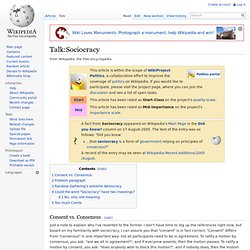
Consensus[edit] Just a note to explain why I've reverted to the former. I don't have time to dig up the references right now, but based on my familiarity with sociocracy, I can assure you that "consent" is in fact correct. "Consent" differs from "consensus" in one important way: not all participants need to be in agreement. To ratify a motion by consensus, you ask: "are we all in agreement? " Ah, that sounds like a good reply to the criticism of political paralysis. By the way, does this not also apply to Wikipedia? Interesting semantics. Problem paragraph[edit] The problem paragraph is: "To apply sociocracy in larger groups a system of delegation is needed in which a group (also named sociocratic circle) chooses representatives who take the decisions for them on a higher level. "(also named sociocratic circle)" in English or Dutch? This article is originally a translation from the Dutch article.
Holacracy and Sociocracy. The history of holacracy and sociocracy as I know it.
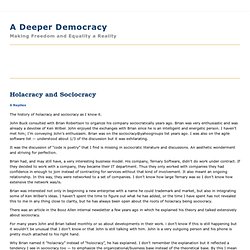
John Buck consulted with Brian Robertson to organize his company sociocratically years ago. Brian was very enthusiastic and was already a devotee of Ken Wilber. John enjoyed the exchanges with Brian since he is an intelligent and energetic person. I haven’t met him; I’m conveying John’s enthusiasm. Brian was on the sociocracy@yahoogroups list years ago. Why I'm So-so About Sociocracy. A couple days I ago Ted posted this note in response to my June 20 blog, Consensus Interruptus.
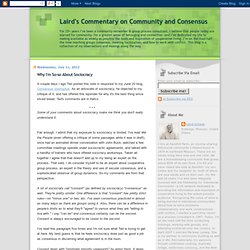
As an advocate of sociocracy, he objected to my critique of it, and has offered this rejoinder for why it's the best thing since sliced bread. Ted's comments are in italics. Some of your comments about sociocracy make me think you don't really understand it.Fair enough. I admit that my exposure to sociocracy is limited. I've read We the People (even offering a critique of some passages while it was in draft), once had an animated dinner conversation with John Buck, watched a few committee meetings operate under sociocractic agreements, and talked with a handful of trainers who have offered socicracy workshops. A lot of sociocrats call "consent" (as defined by sociocracy) "consensus" as well. Critique of Sociocracy. Following is a summary of my reservations about sociocracy (aka Dynamic Governance) as a governance system for cooperative groups—especially ones depending on voluntary participation.
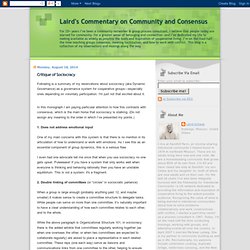
I'm just not that excited about it. The High Level View. Holacracy. Holacracy is a registered trademark of Holacracy One, L.L.C. of Spring City, PA, USA.[1] It has been described as: "essentially a set of inward-looking hierarchical mechanisms that connect 'circles' (of staff).
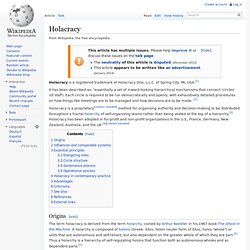
Each circle is required to be run democratically and openly, with exhaustively detailed procedures on how things like meetings are to be managed and how decisions are to be made. [2] Holacracy is a proprietary[citation needed] method for organising authority and decision-making to be distributed throughout a fractal holarchy of self-organizing teams rather than being vested at the top of a hierarchy.[3] Holacracy has been adopted in for-profit and non-profit organizations in the U.S., France, Germany, New Zealand, Australia, and the UK.[4][citation needed] Origins[edit] The term holacracy is derived from the term holarchy, coined by Arthur Koestler in his 1967 book The Ghost in the Machine. Influences and comparable systems[edit] Essential principles[edit]
Cons. Pros. Case Studies. Implement Holacracy. Simon Robinson's take on Holacracy. I have been following the guys at Holacracy for quite a while now and I’ve been meaning to jot down some thoughts in a blog for some time.

In my lectures in complexity I talk a lot about complex systems in nature, for example the ways in which animals swarm, behave intelligently, solve intricate problems and can make life-and-death decisions accurately and repeatedly. I then look at various business case studies such as Kyocera’s Amoeba Management System and Gore Inc’s lattice management structure, noting how they too appear to be based on nature’s principles.
One of the major challenges though is moving from an out-of-date mechanistic top-down hierarchy to a more natural business structure. The results can often be even more complexity: Today`s big companies do very little to enhance the productivity of their professionals.